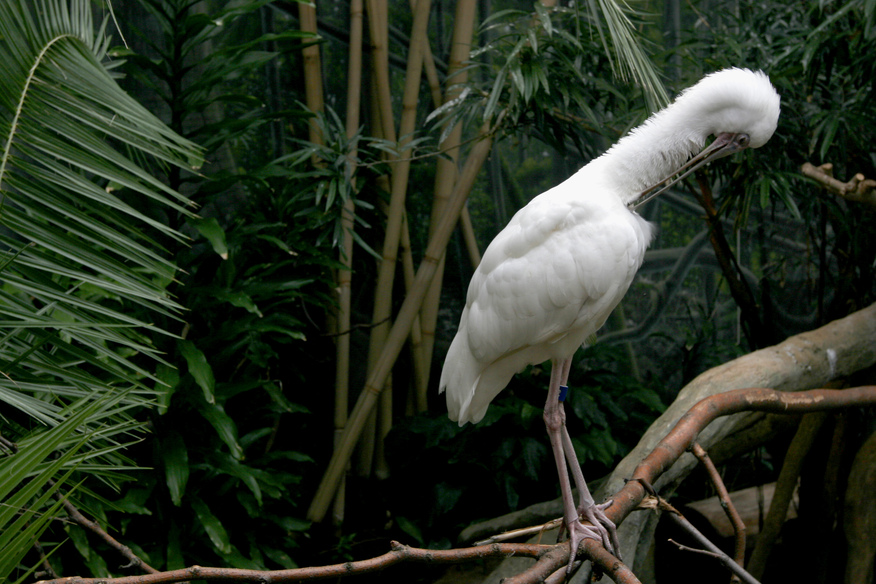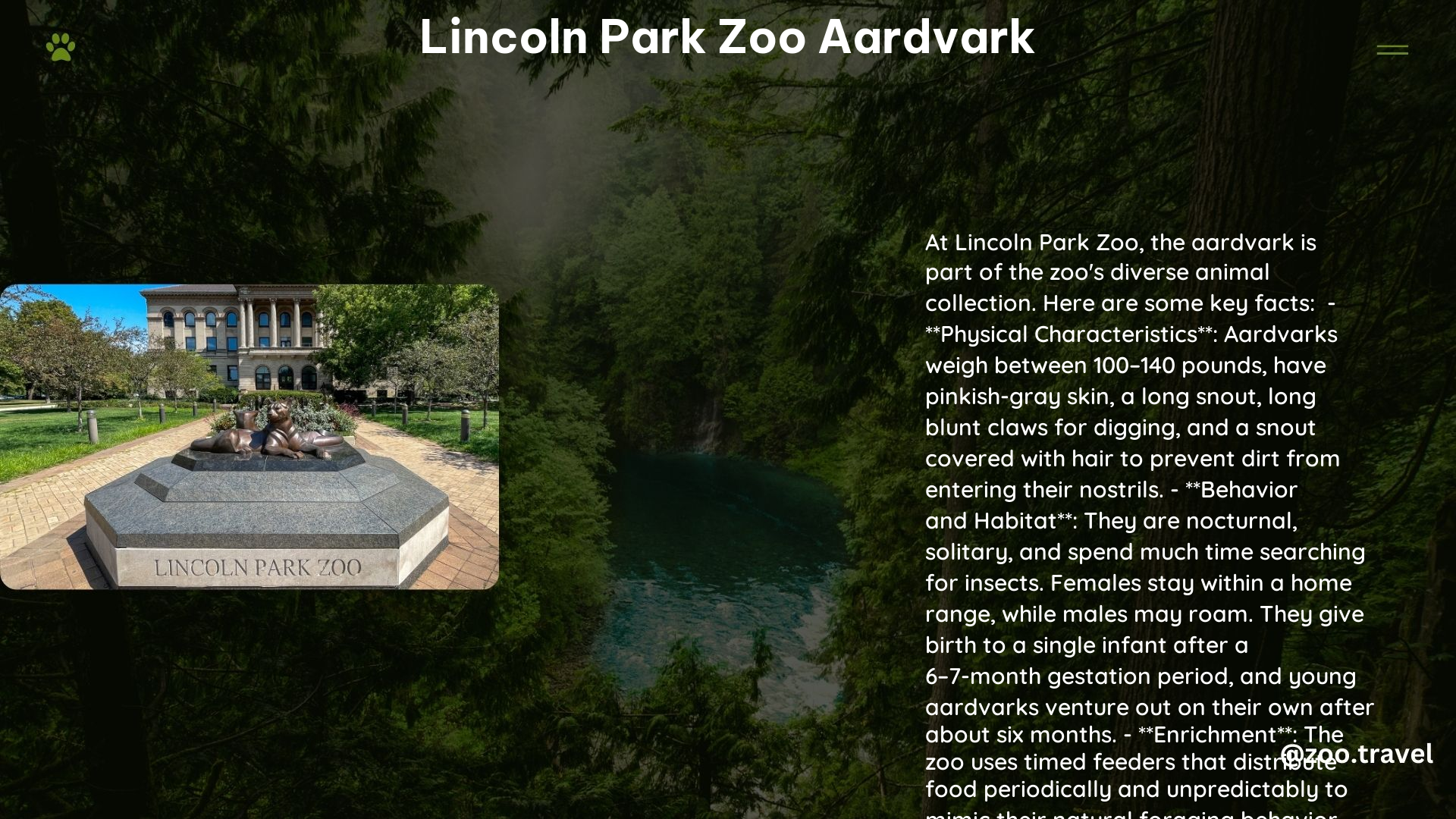The Lincoln Park Zoo aardvark exhibit offers visitors a unique glimpse into the world of these fascinating nocturnal creatures. Located in the Regenstein African Journey, the aardvark enclosure simulates their natural savanna habitat with sandy spaces and artificial termite mounds. The zoo’s commitment to conservation and research ensures optimal care for these unique animals, including specialized diets and enrichment activities.
What Is the Habitat Like for Aardvarks at Lincoln Park Zoo?

The aardvarks at Lincoln Park Zoo reside in a carefully designed habitat within the Regenstein African Journey exhibit. This enclosure aims to replicate the African savanna, providing a naturalistic environment for these unique creatures. Key features of the habitat include:
- Sandy areas for digging
- Artificial termite mounds
- Enrichment elements mimicking natural surroundings
- Integration with other African species exhibits
The exhibit’s design allows visitors to observe the aardvarks in an environment that closely resembles their native habitat, offering both educational value and optimal living conditions for the animals.
How Does Lincoln Park Zoo Meet the Dietary Needs of Aardvarks?

Aardvarks have specific dietary requirements that Lincoln Park Zoo strives to meet with precision. Their diet primarily consists of:
- Ants
- Termites
- Occasional other insects (e.g., scarab beetle pupae)
In the wild, aardvarks can consume up to 50,000 insects per night. The zoo replicates this diet as closely as possible, ensuring the aardvarks receive the nutrition they need. Interestingly, aardvarks swallow their food whole, relying on a muscular area in their lower stomach to grind it up rather than chewing.
The zoo’s nutrition team works diligently to formulate diets that meet the aardvarks’ unique needs, often incorporating:
- Specially prepared insect mixtures
- Nutritional supplements
- Occasional treats for enrichment purposes
What Are the Unique Features of the Aardvark Exhibit?
The aardvark exhibit at Lincoln Park Zoo boasts several unique features designed to promote natural behaviors and provide an engaging experience for visitors:
| Feature | Purpose |
|---|---|
| Sandy Digging Areas | Allows aardvarks to engage in natural foraging behaviors |
| Artificial Termite Mounds | Simulates natural feeding opportunities |
| Night-Vision Viewing Areas | Enables visitors to observe nocturnal activities |
| Interactive Educational Displays | Provides information about aardvark biology and conservation |
These features not only enhance the well-being of the aardvarks but also offer visitors a chance to learn about these fascinating creatures in an immersive setting.
When Can Visitors Observe Aardvark Feeding Times?
While specific feeding times are not publicly detailed, Lincoln Park Zoo takes into account the aardvarks’ natural nocturnal behavior when scheduling feedings. Visitors interested in observing feeding times should consider the following:
- Check with zoo staff for potential viewing opportunities
- Visit during evening hours when aardvarks are more active
- Attend keeper talks or special events focused on aardvarks
It’s important to note that feeding schedules may vary to ensure the aardvarks’ well-being and to provide enrichment through varied routines.
What Care Practices Does Lincoln Park Zoo Implement for Aardvarks?
Lincoln Park Zoo employs a comprehensive care regimen for its aardvarks, focusing on their physical and mental well-being. Key aspects of their care include:
- Participation in the Species Survival Plan® in cooperation with other AZA-accredited zoos
- Regular veterinary check-ups to monitor health
- Enrichment activities to stimulate natural behaviors
- Specialized diets formulated by nutrition experts
- Habitat modifications to enhance comfort and encourage natural behaviors
The zoo’s commitment to individual animal welfare is evident in its science-based approach to care, ensuring that each aardvark receives personalized attention and optimal living conditions.
How Do Zoo Staff Monitor and Maintain Aardvark Health?
Zoo staff play a crucial role in maintaining the health and well-being of the aardvarks at Lincoln Park Zoo. Their responsibilities include:
- Daily health checks and observations
- Regular weighing and physical examinations
- Monitoring food intake and digestion
- Providing appropriate veterinary care when needed
- Implementing preventative health measures
Additionally, the zoo’s research initiatives contribute to a better understanding of aardvark biology and behavior, which in turn informs care practices and conservation efforts.
What Conservation Efforts Does Lincoln Park Zoo Support for Aardvarks?
Lincoln Park Zoo is actively involved in aardvark conservation efforts through various initiatives:
- Participation in the AZA Species Survival Plan®
- Educational programs to raise awareness about aardvarks and their habitats
- Research projects focused on aardvark behavior and biology
- Support for in-situ conservation efforts in Africa
These efforts not only contribute to the preservation of aardvarks in the wild but also enhance the care provided to the individuals at the zoo.
By offering a naturalistic habitat, meeting specific dietary needs, and implementing comprehensive care practices, Lincoln Park Zoo ensures that its aardvarks thrive while also serving as ambassadors for their species, educating visitors about these unique and fascinating creatures.
References:
1. Animals & Exhibits – Lincoln Park Zoo
2. Facts About Aardvarks | Live Science
3. Aardvark – Lincoln Park Zoo
